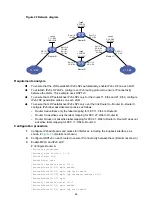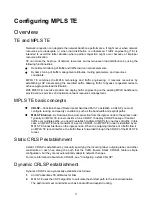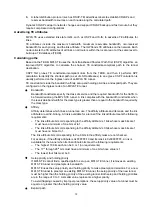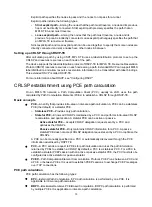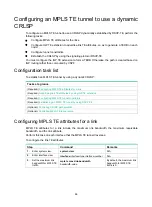
74
As shown in
, PCE 1 is the ABR that can calculate paths in Area 0 and Area 1. PCE 2 is the
ABR that can calculate paths in Area 1 and Area 2. The CRLSP that PCC uses to reach a destination
in Area 2 is established as follows:
1.
PCC sends a path calculation request to PCE 1 to request the path to the CRLSP destination.
2.
PCE 1 forwards the request to PCE 2.
PCE 1 cannot calculate paths in Area 2, so it forwards the request to PCE 2, the PCE
responsible for Area 2 that contains the CRLSP destination.
3.
After receiving the request from PCE 1, PCE 2 calculates potential paths to the CRLSP
destination and sends the path information back to PCE 1 in a reply.
4.
PCE 1 uses the local and received path information to select an end-to-end path for the PCC to
reach the CRLSP destination, and sends the path to PCC as a reply.
5.
PCC uses the path calculated by PCEs to establish the CRLSP through RSVP-TE.
Figure 25 BRPC path calculation
Traffic forwarding
After an MPLS TE tunnel is established, traffic is not forwarded on the tunnel automatically. You must
direct the traffic to the tunnel by using one of the following methods:
Static routing
You can direct traffic to an MPLS TE tunnel by creating a static route that reaches the destination
through the tunnel interface. This is the easiest way to implement MPLS TE tunnel forwarding. When
traffic to multiple networks is to be forwarded through the MPLS TE tunnel, you must configure
multiple static routes, which are complicated to configure and difficult to maintain.
For more information about static routing, see
Layer 3—IP Routing Configuration Guide
.
Policy-based routing
You can configure PBR on the ingress interface of traffic to direct the traffic that matches an ACL to
the MPLS TE tunnel interface.
PBR can match the traffic to be forwarded on the tunnel not only by destination IP address, but also
by source IP address, protocol type, and other criteria. Compared with static routing, PBR is more
flexible but requires more complicated configuration.
For more information about policy-based routing, see
Layer 3
—
IP Routing Configuration Guide
.






